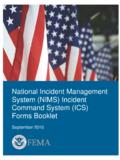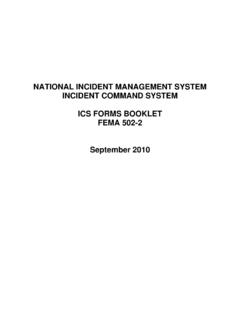Transcription of CIVIL ENGINEER EXPEDITIONARY FORCE …
1 CIVIL ENGINEER EXPEDITIONARY FORCE protection AIR FORCE TACTICS, TECHNIQUES, AND PROCEDURES 1 March 2016 DEPARTMENT OF THE AIR FORCE 2 BY ORDER OF THE AIR FORCE TTP SECRETARY OF THE AIR FORCE 1 March 2016 Operations CIVIL ENGINEER EXPEDITIONARY FORCE protection ACCESSIBILITY: Publications and forms are available on the e-Publishing website at for downloading or ordering. RELEASABILITY: There are no releasability restrictions on this publication. OPR: AFCEC/CXX Certified by: AF/A4C (Maj Gen Timothy S. Green) Supersedes: AFH 10-222V3, 1 May 2008 Pages 83 This publication implements CIVIL ENGINEER FORCE protection requirements and FORCE protection training outlined in AFI 10-210, Prime Base ENGINEER Emergency FORCE (BEEF) Program.
2 It addresses EXPEDITIONARY FORCE protection tactics, techniques, and procedures (TTP) for use by Air FORCE (AF) CIVIL engineers to protect mission-critical assets including personnel, facilities and equipment during deployments. It is applicable to Regular Air FORCE , Air National Guard, and AF Reserve engineers. This publication may be supplemented at any level, but all supplements must be routed to the OPR of this publication for coordination prior to certification and approval. Refer recommended changes and questions about this publication to the Office of Primary Responsibility (OPR) using the AF Form 847, Recommendation for Change of Publication; route AF Forms 847 from the field through the appropriate functional chain of command. Ensure that all records created as a result of processes prescribed in this publication are maintained in accordance 3 with (IAW) Air FORCE Manual (AFMAN) 33-363, Management of Records, and disposed of IAW AF Records Disposition Schedule (RDS) located in the Air FORCE Records Information Management System (AFRIMS).
3 The use of the name or mark of any specific manufacturer, commercial product, commodity, or service in this publication does not imply endorsement by the AF. Chapter 1 Introduction .. 6 Overview .. 6 Scope .. 6 FORCE protection Defined .. 6 FORCE protection Doctrine .. 7 Table FORCE protection Threat Levels .. 7 Integrated Defense (ID).. 8 Emergency Management (EM) .. 8 Critical Asset Risk Management (CARM) Program .. 9 FORCE protection Effects .. 9 FORCE protection Condition (FPCON) System .. 10 Table FORCE protection Conditions .. 11 Terrorist Threat Levels .. 11 Table Determining Terrorist Threat Levels .. 12 Training .. 12 Figure Antiterrorism Training Concept .. 13 Table Antiterrorism Training Levels .. 13 Chapter 2 CIVIL ENGINEER Role in FORCE protection and Antiterrorism.
4 15 Overview .. 15 Figure Berm Construction in Afghanistan .. 15 Antiterrorism (AT) .. 15 Risk Management .. 16 Figure Antiterrorism Risk Management Process .. 17 Random Antiterrorism Measures (RAM).. 19 Chapter 3 FORCE protection Planning .. 21 Overview .. 21 4 Figure FORCE protection Pre-Site Survey in Iraq .. 21 FORCE protection Plan .. 21 Resource Constraints .. 22 Site 24 Site Layout .. 24 Unified Facilities Criteria .. 25 Figure Protective Shelters at a FOB in Afghanistan .. 26 Figure Standoff Distances and Separation for EXPEDITIONARY and Temporary Structures .. 28 Chapter 4 Physical Security .. 29 Overview .. 29 Aspects of Physical Security .. 29 Perimeter Security .. 29 Figure Perimeter Security Measures .. 30 Figure Portable Barrier .. 32 Figure Wedge (Drum) Barrier.
5 33 Figure Retractable Bollards .. 33 Figure Lift Plate Barricade System .. 33 Figure Sliding Gate .. 34 Figure Tire Shredder .. 34 Figure Non-Retractable Bollards .. 35 Figure Steel Hedgehog Barrier .. 35 Figure Expedient Tire Barrier .. 35 Figure Concrete Jersey Barrier .. 36 Figure Sand Bags .. 36 Figure Barriers .. 36 Figure Perimeter Fences and Barriers .. 37 Figure Grille Installed on Drainage Culvert .. 38 Figure Typical Entry Control Facility .. 39 Figure Entry Control Facility Zones .. 41 Figure Jersey Barriers Cabled Together .. 42 Figure Barriers Used to Form Serpentine Path .. 43 5 Figure Berms and Ditches .. 44 Figure Security Lighting and Intrusion Detection System .. 45 Figure Obscuration Screen on Perimeter Fence .. 46 Figure Observation Posts, Guard Towers, and Defensive Fighting Positions.
6 47 Table Barrier Container Sizes and National Stock Numbers .. 47 Figure Illustration of different Sizes of Barrier Containers .. 48 Internal Security .. 48 Figure Internal Security Measures .. 49 Figure Mass Notification System .. 49 Figure EXPEDITIONARY 50 Figure Blast and Fragmentation Hazard Zones .. 51 Figure Compacted Soil Revetment .. 53 Figure Fragmentation Retention Film .. 54 Figure Example of Compartmentalization .. 54 Figure Pre-Detonation Screening .. 55 Figure Revetments .. 56 Figure Personnel Protective Shelter .. 57 Figure EXPEDITIONARY Power Plant at Camp Victory, Iraq .. 58 Figure Burying Utility Lines .. 59 Figure Camouflage Netting Being 60 Figure LOGCAP Power Support at Camp Taji, Iraq .. 61 Chapter 5 Integrated Defense .. 62 Overview .. 62 Integrated Defense Concept.
7 62 Figure AF Integrated Defense Concept .. 63 Desired ID Effects .. 63 Table Threat Deterrence .. 64 Table Threat Detection .. 65 Table Threat Delay .. 66 Attachment 1 Glossary of References and Supporting Information .. 68 Attachment 2 Site Selection and Layout Considerations .. 79 6 Chapter 1 INTRODUCTION Overview. FORCE protection (FP) is critical to the Air FORCE s ability to perform its worldwide mission and is a top priority for commanders. It is a fundamental principle of military operations as a way of ensuring survivability of forces. Commanders at all levels are responsible for protecting Air FORCE people and warfighting resources. However, all Airmen are also responsible for FP and need to be prepared, trained, and equipped to protect and defend operations and assets.
8 This publication provides guidance to CIVIL engineers (CE) on implementing FP measures in the EXPEDITIONARY environment. Many of the references listed throughout this publication are For Official Use Only (FOUO) publications. CE planners maintain copies of these publications and ensure they are available throughout all phases of EXPEDITIONARY operations. Scope. The information in this AFTTP relates to tactics, techniques, and procedures (TTPs) used by CIVIL engineers in supporting precepts outlined in Air FORCE Doctrine Annex (AFDA) 3-34, ENGINEER Operations. It also supports implementation of Air FORCE Policy Directive (AFPD) 10-2, Readiness, and AFI 10-210, Prime BEEF Program. FORCE protection Defined. Joint Publication (JP) 1-02, Department of Defense Dictionary of Military and Associated Terms, defines FP as Preventive measures taken to mitigate hostile actions against Department of Defense personnel (to include family members), resources, facilities, and critical information.
9 FORCE protection does not include actions to defeat the enemy or protect against accidents, weather or disease. By comparison, North Atlantic Treaty Organization (NATO) doctrine explains that the operational environment may have no discernable front-line or rear area and an adversary may be expected to target Allied vulnerabilities anywhere with a wide range of capabilities. Consequently, NATO includes all operations and activities as potential vulnerabilities under FP. The AF definition of FP covers natural and manmade threats. In Air FORCE Instruction (AFI) 10-245, Antiterrorism (AT), the definition includes an integrated approach that requires actions to both defeat the enemy and protect against hazards such as accidents, weather, disease, and natural disasters.
10 The complete definitions are shown in Attachment 1. 7 FORCE protection Doctrine. For much of its existence, the Air FORCE has been able to rely on the US Army when necessary, for standoff security. In fact, in 1985 the Chiefs of Staff of the Air FORCE and Army signed Joint Security Agreement 8 which specified that the Army would provide ground defense outside the perimeter of Air FORCE bases. However, several subsequent joint exercises, as well as experience in Operations Desert Shield and Desert Storm, showed this arrangement was impractical. The formal agreement remained in effect until 2005, at which time Joint Publication 3-10, Joint Security Operations in Theater, codified that the Air FORCE would defend its own air bases. Additionally, for most of the Cold War Air FORCE doctrine was primarily based on the expectation that EXPEDITIONARY bases would be located in a rear area where the threat would be greatly reduced.
















